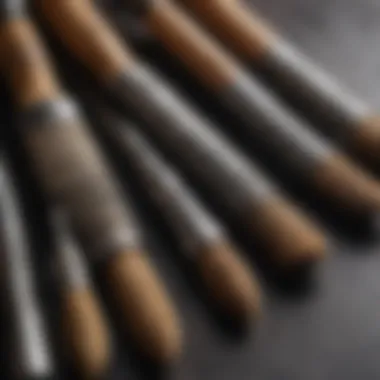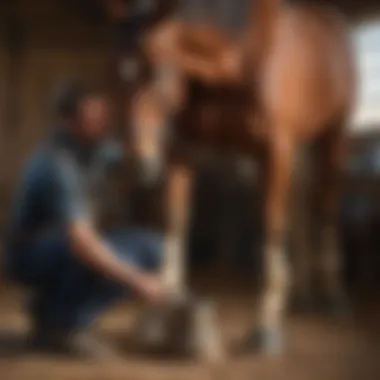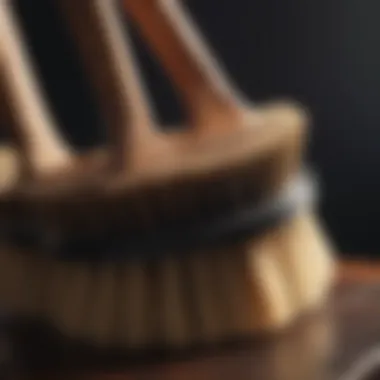Understanding the Farrier’s Brush: A Comprehensive Guide


Intro
The farrier's brush is often overlooked in the vast field of equine care, yet it plays a crucial role in maintaining the health of horses. Understanding this tool requires a closer look at its purposes, types, and best practices. As this guide unfolds, it will become evident how essential the farrier's brush is, not only for cleaning but also for promoting optimal hoof health. In many ways, this brush is an extension of the farrier’s expertise, merging traditional practices with modern techniques.
Key Concepts and Terminology
Basic Definitions
A farrier's brush is specifically designed for grooming and cleaning horse hooves. It typically features a sturdy handle and durable bristles that enable efficient removal of debris, mud, and other elements from the hoof surface. This tool is essential in preventing conditions like thrush and ensuring that the hooves remain healthy and strong.
Other related terms include:
- Hoof Care: The practice of maintaining equine hooves through various methods, including cleaning, trimming, and shoeing.
- Thrush: A bacterial infection common in horse hooves, often resulting from poor hygiene.
Historical Context
The practice of farriery dates back to ancient civilizations. Initially, horses were cared for by general laborers who had experience with animal care. With the increase in horse riding and work, the need for specialized care arose. As society evolved, so did the tools used for hoof care, leading to the modern farrier's brush. Understanding this historical context is important, as it illustrates the evolution of equine grooming practices.
Recent Innovations and Trends
Technological Advancements
In recent years, the farrier’s brush has seen some innovation, particularly in materials used for bristles and handles. Some modern brushes are made from synthetic materials that offer durability without compromising performance. Ergonomic designs have also emerged, aimed at reducing wrist strain during grooming sessions.
Sustainable Practices
Sustainability is becoming a significant focus in many industries, including equine care. Brushes made from biodegradable materials are now available, catering to environmentally conscious horse owners. Additionally, some brands emphasize ethical sourcing for their materials, aligning with a growing awareness of environmental conservation.
Practical Applications and Techniques
Step-by-step Guides
Using a farrier's brush effectively involves several steps:
- Prepare the Horse: Ensure the horse is calm and securely tied or held.
- Inspect the Hoof: Look for any signs of injury or infection before brushing.
- Brush the Hoof: Start by brushing from the heel towards the toe, focusing on crevices.
- Clean Up: Remove debris as you go and discard it properly.
Case Studies
There are several cases where the regular use of a farrier's brush has had a positive impact on horse health. A study conducted on a farm in Kentucky found that horses receiving regular hoof cleaning exhibited fewer issues with thrush and overall better hoof quality compared to those who were not.
"Regular hoof care, including brushing, can dramatically reduce the incidence of infections and improve the overall well-being of horses."
End
In summary, the farrier's brush is an essential tool in any equine care routine. Understanding its proper use, maintenance, and the implications for horse health can greatly enhance care practices. The integration of modern innovations and sustainable practices further reflects the importance of this tool in the evolving landscape of farriery.
Foreword to the Farrier's Brush
The farrier's brush serves as an essential tool in the realm of equine hoof care. This article aims to delineate its significance, providing readers with a nuanced understanding of its various types, functions, and critical maintenance practices. Understanding the farrier's brush is vital not only for practitioners but also for horse owners and enthusiasts who prioritize the health of their animals.
A properly maintained hoof can directly influence a horse's overall well-being, performance, and longevity. Equine care professionals must not overlook the importance of specific tools like the farrier's brush. The delicate act of grooming involves more than just aesthetics; it plays a pivotal role in maintaining the integrity of the hoof.
Definition and Purpose
A farrier's brush is designed specifically for grooming a horse’s hooves. Its primary purpose is to clean the hoof, removing dirt, mud, and debris that may accumulate during daily activities. Often made using a combination of bristles, these brushes help stimulate the hoof and prepare it for more detailed care.
Besides cleaning, the brush also serves to promote healthy hoof growth. Regular use encourages blood circulation and can prevent potential hoof-related issues. Overall, it is an indispensable part of a farrier's toolkit, as it contributes significantly to effective hoof care.


Historical Context
The history of hoof care tools, including the farrier's brush, can be traced back to ancient civilizations. Early mentions of grooming implements indicate that caring for horses was recognized as an important task. In many cultures, farriers were respected professionals, often seen as crucial for a horse's health and well-being.
As equine care evolved, so too did the tools associated with it. The farrier's brush, as we know it today, represents a culmination of centuries of advancements in material and design. Understanding this historical context provides insight into why proper grooming is respected and valued in both modern and traditional settings.
Types of Farrier Brushes
Understanding the various types of farrier brushes is crucial for effective hoof care. Each brush serves a specific purpose, contributing differently to the overall health of a horse's feet. Selecting the right brush type can enhance the grooming process and minimize the risk of hoof problems. This understanding allows farriers and horse owners to make informed decisions when it comes to maintaining a horse’s hoof health.
Bristle Brushes
Bristle brushes play a significant role in hoof care. They are primarily used to remove dirt and debris from the hoof surface without causing harm.
Natural bristles vs. synthetic bristles
Natural bristles, often made from materials like horsehair or pig hair, possess a soft texture. This allows them to be gentle on the hoof while removing dirt effectively. On the other hand, synthetic bristles are often made from nylon or polyester. They offer durability and resist wear but can be harsher on the hoof. The choice between natural and synthetic bristles depends on the specific grooming needs and the horse's hoof sensitivity. Some individuals prefer natural bristles for their softer touch, while others lean towards synthetic options for their robustness and ease of cleaning.
Advantages and disadvantages
Bristle brushes come with distinct advantages. Natural brushes can provide a gentler clean and are biodegradable. However, they might wear out quicker compared to synthetic brushes. Synthetic bristles, while durable, can sometimes feel too stiff for sensitive hooves. Each type presents trade-offs that practitioners should consider based on their specific requirements. This highlights the importance of choosing carefully according to the horse's individual needs.
Hoof Picks
Hoof picks are essential tools for any farrier. They serve primarily to remove stones, dirt, and debris lodged in the hoof. Proper cleaning is vital for preventing infections and ensuring overall hoof health.
Types of hoof picks
Hoof picks come in various shapes and sizes. Some feature curved ends, which are effective for deep cleaning, while others have a straight edge for scrape away larger debris. Additionally, some hoof picks have a brush attached for dual-action cleaning. Choosing the right type can cater to different hoof shapes and sizes, emphasizing the need for versatility. Assessing individual horse needs helps in making this choice.
Choosing the right hoof pick
Selecting the right hoof pick is vital. A good pick should be comfortable to hold and have a durable construction. The design of the handle also matters. Ergonomics are important, as they ensure a firm grip while cleaning. The right pick prevents injury to the hoof and allows for effective debris removal. This careful selection can greatly impact the quality of hoof care provided.
Metal Brushes and Rasp Brushes
Metal brushes and rasp brushes are specialized implements used mostly for more intensive hoof care. They are important for shaping and smoothing the hoof during maintenance.
Characteristics of metal brushes
Metal brushes are designed with stiff, durable bristles made from various metals. They are suitable for removing tough dirt and for smoothing rough spots on a hoof. These brushes can withstand heavy use, making them popular among farriers. The stiffness of the bristles can effectively reach into crevices that softer brushes might miss. However, care must be taken to avoid over-scrubbing, which could lead to irritation or injury.
Usage and care
Proper usage and care of metal brushes are essential. They should be cleaned regularly to prevent the buildup of debris and bacteria. Storing them in a dry place can help maintain their condition and effectiveness. It is also advisable to inspect them for wear and replace them when necessary. Their durability makes them a good investment, provided they are maintained correctly.
Importance of a Farrier's Brush in Hoof Care
A farrier's brush serves multiple essential functions in hoof care, which are critical for maintaining the health and performance of horses. Effective hoof care is paramount, and a quality brush is a fundamental tool in this process. The significance of the farrier's brush lies not only in its ability to clean but also in its role in promoting overall hoof health.
Removing Debris and Dirt
Hooves are often exposed to various elements. Dust, mud, and other debris can accumulate, leading to potential problems. Regular use of a farrier's brush helps remove these contaminants. It is essential to maintain clean hooves to prevent infections and other complications.
When dirt persists, it can lead to a host of issues, including thrush. This is a painful condition resulting from the growth of bacteria in a dirty hoof. Using the brush effectively helps to dislodge particles that may not be easily visible. A thorough cleaning with the right brush ensures that a horse's hooves are in optimal condition, allowing it to perform at its best.
Professional farriers often recommend brushing after each exercise or at the conclusion of a grooming session. This routine reinforces hoof hygiene, which is crucial for both domestic and working horses.
Promoting Healthy Hoof Growth


Beyond cleaning, a farrier's brush plays a vital role in promoting healthy hoof growth. A well-groomed hoof positively impacts circulation, which in turn enhances growth. Regular brushing stimulates the hoof and encourages blood flow, essential for a healthy hoof structure.
Inadequate maintenance can lead to poor growth, resulting in weak hooves that are more susceptible to cracks and other problems.
In summary, the importance of a farrier's brush extends into the realms of hygiene and health. By effectively removing debris and promoting growth, farriers can ensure the horse remains sound and performs well. This highlights why every equine professional and owner should prioritize the use of a quality farrier's brush as part of their hoof care routine.
Techniques for Effective Use
Effective use of the farrier's brush is crucial for maintaining horse hoof health. Understanding how to maximize the benefits of each brush type ensures that farriers can provide optimal care to their equine clients. Proper techniques not only enhance cleanliness but also promote healthy hoof growth and prevent potential issues that could arise from neglect.
Basic Cleaning Techniques
The primary function of a farrier's brush is to clean the hoof effectively. Regular brushing helps remove dirt, manure, and debris, which can cause infections or other hoof-related problems. Here are some basic cleaning techniques:
- Start with the Hoof Pick: Before using the brush, it is essential to use a hoof pick to remove larger clumps of dirt or stones lodged in the hoof. This step ensures that the brush can work more effectively.
- Use Long Strokes: When brushing, maintain long, even strokes following the direction of the hair growth. This technique avoids damaging the hoof and promotes better movement of the brush through the hair and debris.
- Be Gentle: Never apply excessive pressure while brushing. Too much force can damage both the brush and the hoof, leading to more significant issues in the long run.
- Regular Maintenance of Brushes: After each use, clean the brush itself to remove debris that may have accumulated. This practice prevents the transfer of dirt to other hooves, which can be detrimental to the horse’s overall health.
- Disinfect When Necessary: In cases where a horse has demonstrated hoof issues, disinfecting the brush after use is critical. This step helps prevent the spread of infections.
When to Use Different Brushes
Different brushes serve distinct purposes. Understanding when to implement each type is vital for effective grooming. Here are recommendations for when to use various brushes:
- Bristle Brushes: Ideal for general cleaning. Use them after a hoof pick to ensure any remaining dirt and debris are removed effectively.
- Metal Brushes: Best for heavily soiled hooves or removing tougher substances that a bristle brush might not handle. Use these less frequently due to their abrasive nature.
- Rasp Brushes: Utilize rasp brushes strategically, mainly in instances where hoof care aligns with trimming or filing. They can assist in smoothing the hoof surface.
- Natural vs. Synthetic Brushes: Choose synthetic brushes for wet or muddy conditions as they usually offer better durability. In contrast, natural bristle brushes are excellent for dry environments and can provide a gentler clean.
Using the correct brush for the task can save time and ensure quality care. Maintaining a routine not only enhances the horse's hoof health but also simplifies the farrier's job. Understanding these simple yet effective techniques is essential for all individuals involved in equine care.
Maintenance of Farrier Brushes
Maintaining farrier brushes is crucial for several reasons. First, a clean and well-maintained brush enhances its effectiveness in hoof care. When brushes are free from debris and bacteria, they can perform their intended functions without introducing risks to the horse's health. Additionally, proper maintenance prolongs the life of the brushes, making them a more cost-effective investment in the long run.
The time spent on maintenance can also prevent the transmission of infections or diseases between horses. Brushes that are not cleaned regularly can harbor harmful pathogens, which may lead to serious health complications. Thus, maintaining brushes is not just a matter of preserving tools; it is intimately connected to the overall welfare of the equine it serves.
Cleaning and Sanitizing
Cleaning farrier brushes should become a regular part of your grooming routine. After each use, it is essential to remove any mud, hair, and debris that may have collected on the bristles. Using a stiff bristle brush or a hoof pick can effectively dislodge dirt and other particles. If the brush is heavily soiled, soaking it in warm soapy water may be necessary.
Subsequently, sanitizing the brush is a key step to ensure that no harmful organisms remain. A solution of diluted bleach or a specialized disinfectant can be effective. Simply soak or spray the brush, and allow it to air dry completely. This practice significantly decreases the risk of spreading issues like thrush or other hoof infections.
Storage and Care Tips
Proper storage of farrier brushes can enhance their lifespan and maintain their functionality. Brushes should be stored in a dry, cool environment to prevent deterioration of the bristles and hardware. A clean storage container can help keep the brushes organized and protected from dirt and moisture.
It is wise to avoid stacking brushes, as the bristles may become misshapen or damaged. Instead, consider hanging them or arranging them in a way that allows air circulation. Additionally, periodically check on the brushes for any signs of wear or degradation. If a brush shows significant damage, consider replacing it to maintain quality hoof care.
"The effectiveness of grooming tools is directly linked not only to their design but also to their maintenance, proving that diligence in care yields benefits."
In summary, diligent cleaning, sanitizing, and careful storage of farrier brushes are critical practices that ensure optimal performance and hygiene in hoof care.
Choosing the Right Brush
Choosing the right brush is an fundamental yet often overlooked aspect of farriery. A well-chosen brush can significantly impact hoof health. Each horse has unique needs based on various factors such as hoof condition and type. Therefore, understanding these elements is crucial for optimal hoof care. When selecting a brush, it is important to recognize that not all brushes serve the same purpose. The right choice leads to more effective grooming, which in turn promotes the well-being of the horse.
Factors to Consider
Horse type and hoof condition
Horses come in different breeds, each with distinct hoof characteristics. For example, draft horses have larger, sturdier hooves, while Arabian horses have finer, more delicate feet. Selecting a brush that matches the horse type is essential for effective grooming. If a horse has a rocky hoof texture, a specific brush can help manage this. Conversely, if a horse has softer hooves, using a harsher brush might cause damage. Understanding these nuances ensures a tailored approach to hoof care.
- Key Characteristics:


- Draft Horses: Require brushes with sturdier bristles for their large hooves.
- Arabian Horses: Benefit from finer brushes that are gentler on their delicate hoof structures.
Understanding the hoof condition aids in determining which brushes will be effective. For instance, a healthy hoof might need routine care with a softer brush, while a hoof with thrush should be treated with a brush designed for deep cleaning.
Personal preference
Personal preference plays a significant role in choosing farrier brushes. Every farrier has unique methods and comfort levels. A brush that feels good in the hand can make a significant difference in how effectively a farrier works. It is vital for each farrier to experiment with different brushes to find the one that feels right for them. Some may prefer a more ergonomic handle design, while others may opt for a specific type of bristle material that suits their technique.
- Unique Features:
- Ergonomics: Brushes designed for comfort can enhance precision in movement.
- Bristle Material: Natural or synthetic material can influence the effectiveness of cleaning.
Overall, personal preference can guide farriers towards brushes that allow them to work efficiently while promoting the comfort and well-being of the horse.
Budget Considerations
When evaluating brush options, the budget is often a primary concern. Quality farrier brushes can range considerably in price. Investing in a high-quality brush is often more beneficial in the long run compared to purchasing cheaper alternatives which may wear out quickly or perform poorly. While it's tempting to choose the least expensive option, considering longevity and effectiveness can lead to better outcomes for hoof health.
- Cost-Effective Strategies:
- Research different brands and their reputations before making a purchase.
- Consider buying brushes in sets for greater savings yet maintaining quality.
"A well-maintained hoof is part of a healthy horse. Choosing the right brush is vital for both."
In summary, choosing the right brush involves careful consideration of horse type, hoof condition, personal comfort, and budget. Prioritizing these factors leads to optimal grooming and healthier hooves.
The Role of Farriers in Equine Health
Farriers play a crucial role in the overall health and well-being of horses. Their work extends beyond simply shoeing horses; they are pivotal in ensuring proper hoof care, which is essential for a horse's mobility and performance. The relationship between hoof care and general equine health is direct and undeniable. Poor hoof health can lead to a myriad of issues, including lameness, which can severely affect a horse's quality of life.
Farrier Training and Skills
A qualified farrier possesses specialized training that encompasses various skills. This training often includes an understanding of hoof anatomy, the ability to recognize hoof-related ailments, and expertise in the proper use of farrier tools, including brushes. Farrier training programs usually cover anatomy, shoeing techniques, and the application of appropriate hoof care practices. Mastery of these areas ensures that farriers are equipped to provide exceptional care.
Techniques learned typically involve:
- Correct trimming methods: This helps maintain the natural shape and function of the hoof.
- Shoeing procedures: A farrier must know how to select and apply shoes to support a horse's specific needs.
- Hoof health assessments: Identifying signs of issues such as cracks, thrush, or laminitis is essential for preventative care.
Ultimately, ongoing education in the field remains essential as new methods and innovations continue to emerge.
Understanding Hoof Anatomy
To effectively care for horses, farriers must have a solid grasp of hoof anatomy. Hooves are complex structures, consisting of different parts that contribute to their function and health. A farrier must recognize the significance of various components, such as the sole, frog, and walls of the hoof.
Key elements of hoof anatomy include:
- Wall: The hard outer layer that protects sensitive structures inside the hoof. It also bears the weight of the horse.
- Sole: The bottom of the hoof, which provides protection while also allowing the horse to feel its surroundings.
- Frog: A rubbery structure that aids in shock absorption and helps pump blood back up the leg when the horse walks.
Understanding how these parts interact aids farriers in identifying any deviations from normal structure, which can indicate underlying health problems. For instance, knowledge of hoof circulation helps prevent conditions like laminitis and enables timely interventions.
Epilogue
The conclusion of this article reinforces the essential role of the farrier's brush in maintaining equine hoof health. Understanding this fundamental tool not only enhances the skills of farriers but also promotes better care for horses. Hoof health directly influences a horse's overall well-being and performance, making the correct choice and use of farrier brushes paramount.
Summary of Key Points
- Types of Brushes: Different brushes serve specific purposes, such as bristle brushes for debris removal and metal brushes for tougher hoof care issues.
- Maintenance: Proper cleaning and storage of brushes extend their longevity and effectiveness, which is a vital practice for professionals.
- Farrier Skills: Training and expertise in hoof care directly impact the results achieved, showing the importance of skilled practitioners in this field.
- Hoof Health Impacts: Healthy hooves contribute significantly to a horse's performance and overall health, making the role of grooming tools crucial.
Future of Farriery
As the equine industry evolves, the future of farriery will likely incorporate advanced materials and technologies in grooming tools. Potential developments may include:
- Smart Technology: Sensors integrated into brushes to monitor hoof condition in real-time.
- Sustainable Materials: Increased use of eco-friendly materials for brushes, meeting the growing demand for sustainability.
- Education and Training: Online resources and courses will continue to enhance the skills of both novice and experienced farriers.
In summary, the farrier's brush is not just a simple tool but a vital component in equine care. Continuous learning and adaptation will ensure farriers can meet the needs of diverse horse types while advocating for their health.















